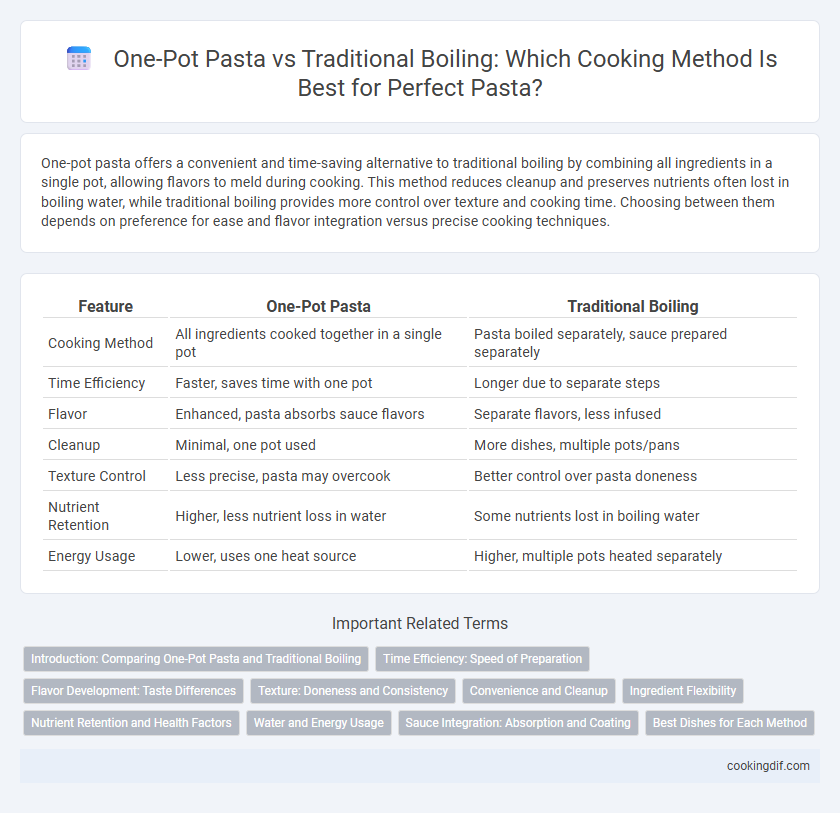One-pot pasta offers a convenient and time-saving alternative to traditional boiling by combining all ingredients in a single pot, allowing flavors to meld during cooking. This method reduces cleanup and preserves nutrients often lost in boiling water, while traditional boiling provides more control over texture and cooking time. Choosing between them depends on preference for ease and flavor integration versus precise cooking techniques.
Table of Comparison
| Feature | One-Pot Pasta | Traditional Boiling |
|---|---|---|
| Cooking Method | All ingredients cooked together in a single pot | Pasta boiled separately, sauce prepared separately |
| Time Efficiency | Faster, saves time with one pot | Longer due to separate steps |
| Flavor | Enhanced, pasta absorbs sauce flavors | Separate flavors, less infused |
| Cleanup | Minimal, one pot used | More dishes, multiple pots/pans |
| Texture Control | Less precise, pasta may overcook | Better control over pasta doneness |
| Nutrient Retention | Higher, less nutrient loss in water | Some nutrients lost in boiling water |
| Energy Usage | Lower, uses one heat source | Higher, multiple pots heated separately |
Introduction: Comparing One-Pot Pasta and Traditional Boiling
One-pot pasta cooking streamlines meal preparation by combining pasta, sauce, and ingredients in a single pot, enhancing flavor infusion and reducing cleanup time. Traditional boiling involves separately cooking pasta in a large pot of salted water, requiring draining before mixing with sauce, which can sometimes cause nutrient loss and energy inefficiency. The one-pot method maximizes starch absorption into the sauce, offering a quicker, more cohesive texture compared to the conventional two-step boiling and draining process.
Time Efficiency: Speed of Preparation
One-pot pasta significantly reduces cooking time by combining boiling, sauteing, and simmering steps into a single process, eliminating the need to separately cook pasta and sauce. Traditional boiling methods require pre-boiling water and multiple stages for draining and combining ingredients, resulting in longer preparation times. The streamlined approach of one-pot pasta enhances time efficiency, making it ideal for quick meals without sacrificing flavor or texture.
Flavor Development: Taste Differences
One-pot pasta enhances flavor development by allowing ingredients like garlic, herbs, and spices to infuse directly into the pasta as it cooks, creating a more integrated taste profile. In contrast, traditional boiling often results in a more neutral pasta flavor since noodles are boiled separately and then combined with sauce later. The prolonged simmering in one-pot methods promotes deeper, richer flavors through ingredient interaction that boiling alone cannot achieve.
Texture: Doneness and Consistency
One-pot pasta offers a unique texture by allowing the pasta to absorb flavors while cooking in the sauce, resulting in a creamy consistency with evenly tender noodles. Traditional boiling achieves a more consistent al dente doneness by controlling cooking time in ample water, preventing starch release that can cause stickiness. The choice between methods impacts the pasta's firmness and sauce integration, with one-pot favoring a cohesive, softer texture and boiling preserving distinct, firm strands.
Convenience and Cleanup
One-pot pasta simplifies meal preparation by combining all ingredients into a single pot, significantly reducing both cooking time and the number of dishes to wash. Traditional boiling requires separate pots for pasta and sauce, increasing complexity and cleanup efforts. This streamlined approach offers a highly convenient solution for quick and efficient pasta meals.
Ingredient Flexibility
One-pot pasta offers greater ingredient flexibility by allowing vegetables, proteins, and sauces to cook simultaneously with the pasta, enhancing flavor integration and simplifying preparation. Traditional boiling requires separate cooking steps, limiting the ability to combine diverse ingredients directly in the pasta water without compromising texture or taste. This method also reduces the need for multiple pots and ingredients timing adjustments, making one-pot pasta ideal for quick, varied meals.
Nutrient Retention and Health Factors
One-pot pasta cooking preserves more water-soluble vitamins like B-complex and vitamin C due to reduced water usage and shorter cooking time compared to traditional boiling methods. This method minimizes nutrient leaching, enhancing the pasta's overall nutritional profile, including higher retention of antioxidants and essential minerals. Health factors improve as the one-pot technique reduces the need for added fats and oils, promoting a lower-calorie and heart-friendly meal option.
Water and Energy Usage
One-pot pasta cooking significantly reduces water consumption by using a single pot where pasta absorbs water directly, unlike traditional boiling which requires large volumes of constantly boiling water. This method also conserves energy due to shorter cooking times and less heat loss, making it more efficient compared to the extended boiling process. Reduced water and energy usage in one-pot pasta aligns with sustainable kitchen practices and lowers utility costs.
Sauce Integration: Absorption and Coating
One-pot pasta allows the noodles to absorb sauce flavors directly during cooking, resulting in a more integrated and richly coated dish compared to traditional boiling where pasta is cooked separately and then combined with sauce. This method enhances the starch release into the sauce, improving its thickness and adherence to the pasta. Traditional boiling often requires additional steps to achieve the same level of sauce absorption and coating, making one-pot pasta a more efficient and flavor-infused technique.
Best Dishes for Each Method
One-pot pasta excels with recipes requiring rich, integrated flavors like creamy tomato basil or garlic butter shrimp, as all ingredients cook together, enhancing depth. Traditional boiling suits pasta shapes needing separate sauce preparation, such as al dente spaghetti with classic marinara or pesto, allowing precise control over texture and seasoning. Selecting the cooking method depends on the desired dish complexity, ingredient infusion, and texture precision.
One-pot pasta vs traditional boiling for cooking method Infographic

 cookingdif.com
cookingdif.com